ISSN ONLINE(2278-8875) PRINT (2320-3765)
ISSN ONLINE(2278-8875) PRINT (2320-3765)
| K. Harisudha, Souvik Dinda, Rohit Kamal, Rahul Kamal Department of Information and Telecommunication, SRM University, Chennai, India |
| Related article at Pubmed, Scholar Google |
Visit for more related articles at International Journal of Advanced Research in Electrical, Electronics and Instrumentation Engineering
Ultra wideband (UWB) is based on transmission with very short pulses of low energy. The use of UWB technology will increase in the fields of wireless communication in the near future. The wider bandwidth of UWB technology has several advantages such as excellent penetration ability, multi-user support and high channel capacity. UWB has many applications due to its low power consumption, low cost and low interference. UWB poses design challenges for low power and low complex systems at wider bandwidth. For digital systems, it also requires high sampling rate and intensive computation to estimate gain and delay of multipath channel. In this paper, the performance of non-coherent transmitted reference (TR), frequencyshifted reference (FSR) and code-shifted reference (CR) systems are compared with the Wa l s h coded reference (CR) systems for single and multi-user for low data rates. The results show that CR shows better performance than TR a nd FS R i n b o t h s i ng l e us e r a nd mu l t i us e r e n vi r o nme nt .
Keywords |
| TR, FSR, CR |
INTRODUCTION |
| The concept of Ultra-Wideband technology (UWB) was developed in late 1960s. Impulse measurement techniques were applied to the design of wideband antenna elements, leading to the development of short-pulse radar and communications systems in late 1960s. The first UWB communication patent was awarded for a short-pulse receiver in 1973. UWB was termed as baseband, carrier-free, or impulse technology in 1980s [4]. A popular modulation technique for UWB pulses Souvik Dinda was introduced in 1993 by R. A. Scholtz under the name Impulse Radio. A significant change occurred in February 2002, when the U.S. Federal Communication Commission (FCC) issued UWB rulings for transmission and use of unlicensed bandwidth for data communication as well as radar and safety applications. |
| UWB is an emerging technology with several communication advantages [2]. In near future, indoor communication of any digital data, from high-speed signals carrying multiple High - Definition Televisions (HDTV) programs to low-speed signals used for timing purposes will be shared over a digital wireless network. Such networks will requires high data rates, very low cost and very low power consumption. The band allocated for UWB communications is 7.5, i.e., between 3.1 to 10.6. The maximum power available to a transmitter is approximately 0.5, if the entire 7.5 band is optimally utilized [1]. |
| According to the new definition of FCC and ITU-R, UWB can be defined in terms of transmission from an antenna for which the emitted signal bandwidth exceeds the slightest of 500 or 20% of the central frequency [5]. According to FCC, the UWB systems can operate in the range of 3.1 to 10.6, with the power spectral density (PSD) satisfying a specific spectral mask shown in Fig. 1. To control the radio interference, the PSD of a UWB signal must follow the part 15 general emission limits. From the spectral mask of Fig. 1, it is obvious that the PSD of a UWB signal measured in the 1 MHz bandwidth must not exceed −41.3. |
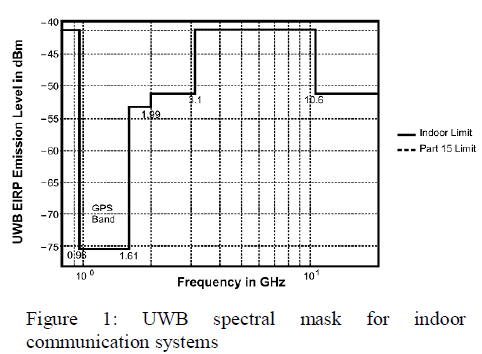 |
| Characteristics of UWB are: |
| UWB signals have many attractive features such as, |
| UWB signals have a noise-like signal spectrum; |
| UWB signals are resistant to severe multipath and jamming; |
| UWB signals have very good timedomain resolution allowing for location and tracking applications |
Applications of UWB are: |
| UWB technology can enable a wide variety of applications in wireless communications, networking, radar imaging, and localization systems. For wireless communications, the use of UWB technology offers significant potential for the deployment of two basic communications systems, |
| High-data-rate (HDR) short-range communications: high-data-rate wireless personal area networks. |
| Low-data-rate (LDR) and location tracking: sensor, positioning, and identification networks. |
IR-UWB RECEIVERS |
A. Transmitted Reference UWB Receiver |
| UWB systems performance is highly dependent on the timing requirements mainly due to strict power limitations and short pulse durations. When simple and low cost systems are desired, that references locally, estimates the channel and captures enough energy for correct UWB data detection, it is difficult to design such receivers Transmitted-Reference (TR) [5]. |
| UWB wireless communication systems can relax the difficult UWB timing requirements and can provide a simple receiver that gathers the energy from the many resolvable multipath components. TR receiver represents a low complexity alternative to RAKE-receivers. TR signalling can be viewed as a signalling scheme which devotes a portion of the transmitted energy to channel measurement. TR systems operate by transmitting signals consisting of separable data and reference portions over random time-varying communication channels. After separating the data and the reference portions of the received signal, the receiver correlates them to form a decision variable. The modulation of these sequences of pulses can be PPM or PAM. BPSK is used only in conjunction with coherent receivers, and gives better performance than PPM since it is an antipodal modulation format. The symbol interval is defined as and frame interval as for TR-UWB systems. Each frame interval includes a UWB impulse, and , 1. In the standard TR-UWB system, the transmission signal during the symbol period can be expressed as follows, |
 |
 |
| In TR, first transmit a reference pulse of known fixed polarity (or position), followed by a data pulse whose polarity (position) is determined by the information bit. At the receiver, the received signal is multiply with a delayed version of itself as shown in Fig. 2. By transmitting a reference along with the data, it is possible to eliminate the need for a locally generated reference (LGR) and the complicated issue of LGR synchronization. Since TR systems utilizes part of the available power for the reference portion of the signal, the elimination of LGR and its complication come at the cost of decreased power dedicated for data transmission. |
| TR-UWB architecture has many attractive properties: |
| Since the reference signal is transmitted over the same channel as the data signal, it provides a perfect template to match the data pulse without explicit channel estimation, but corrupted with noise, causing degradation at the receiver during the demodulation process. |
| Simple timing acquisition can be achieved by repeating as many times per symbol as desired and having the receiver integrate across these many frames; thus, timing is only required at the symbol level, which can be an important gain in low data rate applications, where often âÃâ°Ã« . |
| Reference pulse and the data pulse are transmitted within one frame; the channel need only be constant over the frame time. This can be significant for systems operating in a highly mobile environment. |
| At the receiver, it is essential that a low-pass filter be used prior to the correlation, to limit the noise. In, it has been described that multiple doublets per chip can be considered to increase range/low data rate applications. In practical systems, it is worthwhile to randomize the polarity of the first (reference) pulse, which will reduce spectral lines |
 |
B. Frequency-Shifted Reference UWB Receiver |
| The TR technique has been proposed as an intellectual solution to the UWB receiver design problem that provides a simple form of UWB multiple-access (MA), mostly for low data rate applications [6]. TRUWB system, separate the reference signal and data signal by a time delay and the data pulses are modified by antipodal bits. Since the reference signal goes through the same channel as the data signal, thus can serve as a template for the channel distorted data signal, the receiver simply correlates the received data signal and a delayed version of itself to capture all of the energy of the data-bearing signal. Despite the apparent simplicity of the architecture of the TR-UWB receiver, it is not an easy task to accurately build an extremely wideband delay element. To avoid the wideband delay element in the receiver, and, has proposed the slightly frequency-shifted reference (FSR) UWB system. The implementation of a frequency translation of a wideband signal is much simpler than the delay of the same signal, the technique considered is to employ a very carefully selected frequency-translated reference; in other words, the reference is translated in frequency rather than time to be orthogonal to the data bearing signal, and so avoids the delay element. The orthogonality of the reference and data signal does not have to be imposed over each frame period, but rather over a symbol period. Thus, a frequency offset between the reference impulse train and data impulse train is prescribed that is only the inverse of the symbol period. This frequency shift is well below the coherence frequency of the channel, and hence, the reference serves as a suitable reference for the databearing signal. Since the data pulse must go through approximately the same channel as the reference pulse, frequency orthogonality obtained by simply shifting the data pulse is futile, because the frequency separation between the pulses exceeds the coherence frequency of any reasonable fading channel. Hence, a method is sought to obtain an orthogonal reference can be readily accomplished with a mixer. |
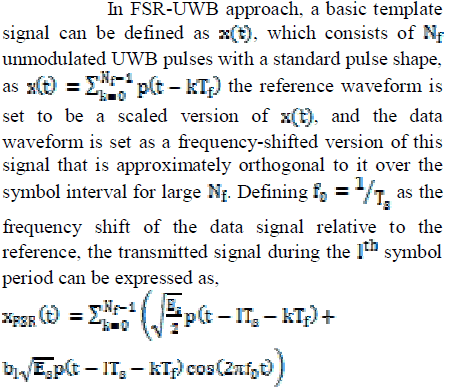 |
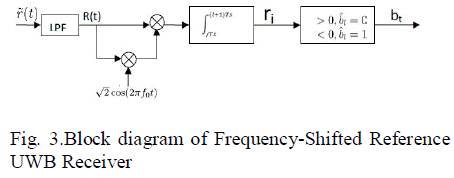 |
C. Code-Shifted Reference UWB Receiver |
| A simpler implementation is achieved in and is referred to as slightly frequency-shifted (SFS) scheme. The data and reference are shifted from each other by the symbol rate . Code-reference IR-UWB is the parallel approach but the base of development is code multiplexing rather than frequency multiplexing. In this scheme, data and reference are derived from amplitude modulating the same pulse train with two orthogonal code sequences [7]. The orthogonality serves to extract the reference at the receiver. In a code-shifted reference UWB approach has been proposed, in which a reference pulse sequence and one or multiple data pulse sequences are transmitted simultaneously, and each pulse sequence is coded by a specific shifting code. Transmission signal during the symbol in CR systems, can be expressed by replacing the single frequency carrier in (2) with , as follows |
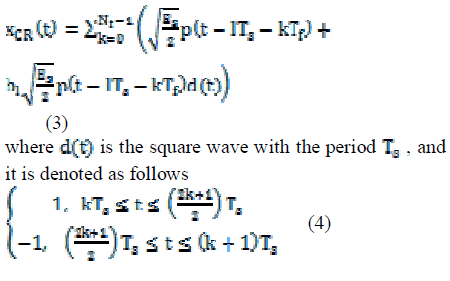 |
| Compare with FSR, the CR scheme has advantages in terms of implementations and performance. CR exhibits the same performance as FSR at low data rates and better performance as the rate increases. CR UWB receiver does not require any delay element, as the pulses are delayed with digital codes instead of frequency tones, and can avoid most performance degradation the FSR UWB systems suffers in conjunction of much lower system complexity |
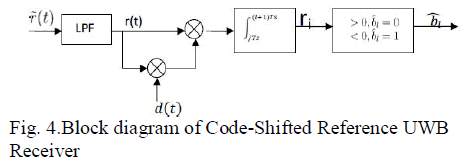 |
SIMULATION RESULTS |
A. Single user simulation result |
| TR vs FSR |
| First, the performance of TR system is compared with FSR system. The frame duration of TR is tf= 200 nsec with = 100 nsec and number of frame per bit is Nf= 2. The frame length of FSR is = 100nsec with number of frames per bit Nf= 4. We observe from the Fig. 5, that the performance of TR system is better than FSR system. TR outperforms FSR by 2dB [5]. |
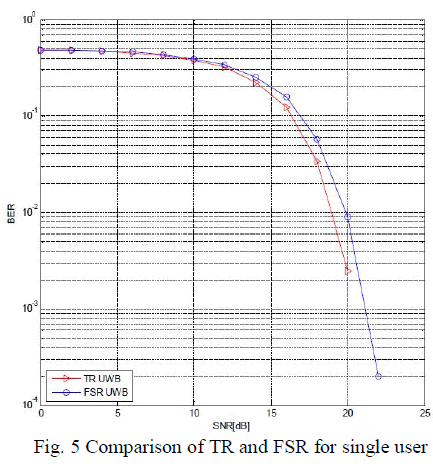 |
| TR and FSR vs CR |
| The performance of CR UWB system is compared with TR and FSR UWB systems. The parameters of TR and FSR are the same as in Fig. 5, for CR UWB system, the frame duration is = 100 nsec with = 4. The code sequence in CR system is selected from 2×2 Hadamard matrix. From the Fig. 6, it is observed that the performance of CR is better than FSR by 2dB [7], while the performance of CR and TR are almost the same. |
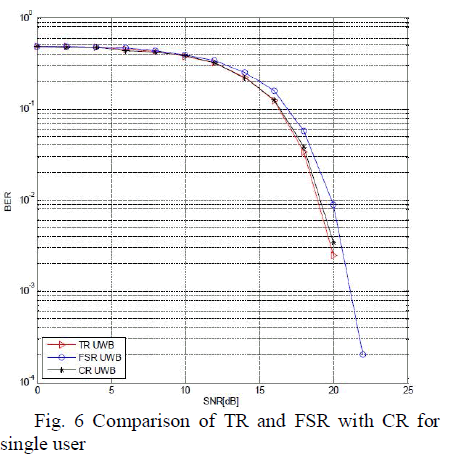 |
B. Multiuser Simulation Result |
| TR vs FSR with 3 interfering users |
| The performance of TR and FSR systems are compared for multi-user. The frame length of TR is = 600 nsec with = 300 nsec and the number of frames per bit is = 6. The chip duration is = 75 nsec. The number of hops = 4, with hopping time period is = 1000. The frame duration of FSR is = 300 nsec, and number of frames per bit = 11. The chip duration is = 75 nsec, with number of hops = 4, and time hopping period = 1000. From the Fig. 7, we observe that, due to the presence of IFI, the performance of TR flat out at higher SNR, however the performance of TR is better than FSR [7]. |
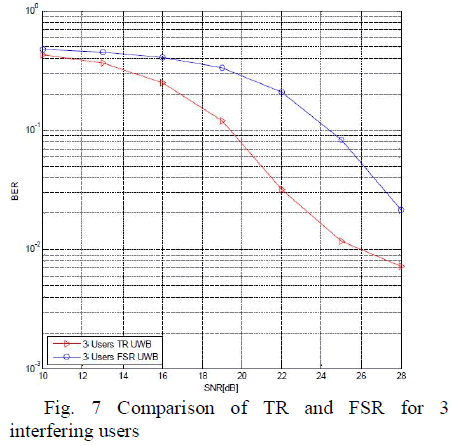 |
| TR and FSR vs CR for 3 interfering users |
| The performance of CR is compared with TR and FSR for multi-user. The parameters of TR and FSR systems are same as Fig. 7. The frame duration of CR is = 100 nsec, with number of frames per bit = 32. Walsh code sequence of × order is generated. The common sequence for reference pulses for all users are chosen from the first ⁄2 code sequence. The first row is selected from code sequence for reference pulse. The remaining ⁄2 code sequence is used of the user data pulse. Different code sequence is used for different user’s data pulse. From the Fig. 8, it is observed that the performance of CR is better than FSR system, but TR has better performance between 14dB and 22dB. As SNR is increased, the performance of TR become flat due IFI, while the performance of CR turn out to be better than TR [7]. |
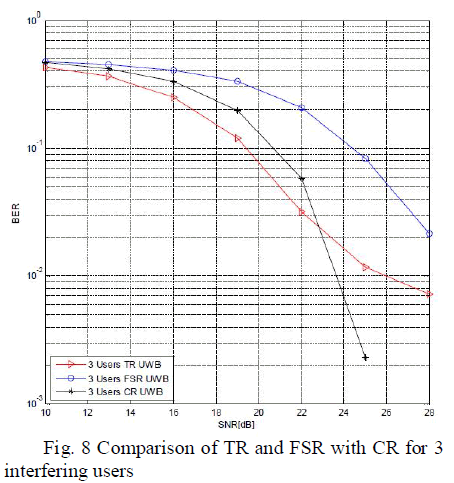 |
CONCLUSION |
| From the simulation results obtained and the observations it is proved that the performance of CR is better than TR and FSR in multiuser and is better than FSR in single user environment in terms of BER at low data rates. It has been observed that, in single-user environment, TR and CR outperform FSR by 2dB. However, the performance of TR and CR are the same. In multi-user environment, TR has less bit error rate than FSR; on the other hand, CR outperforms FSR by 3dB. However, at low SNR, TR has better results than CR, and as the SNR increases, CR outperforms TR by 3dB. |
References |
|